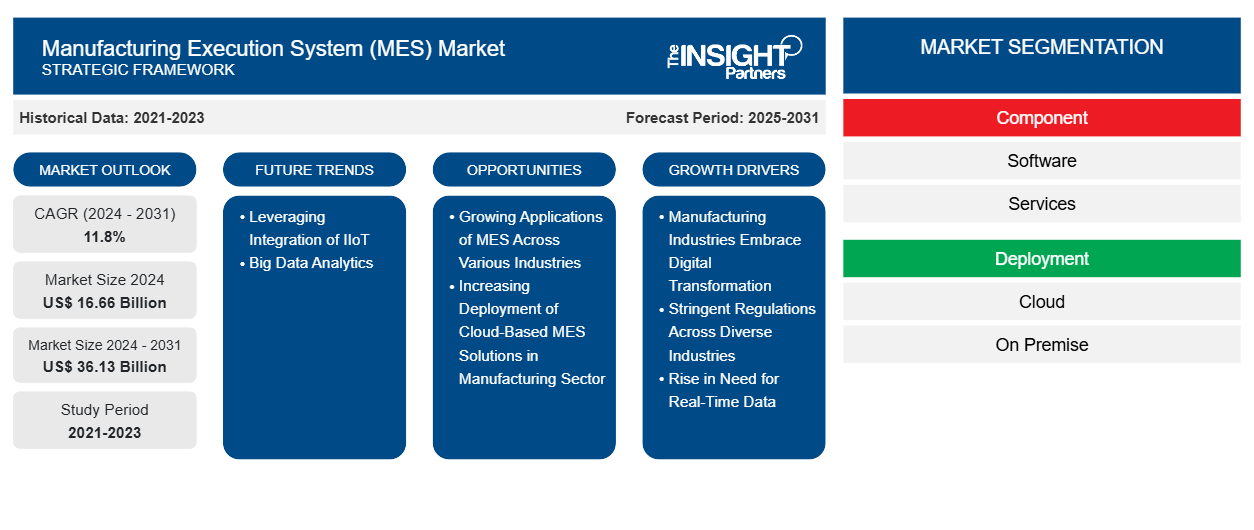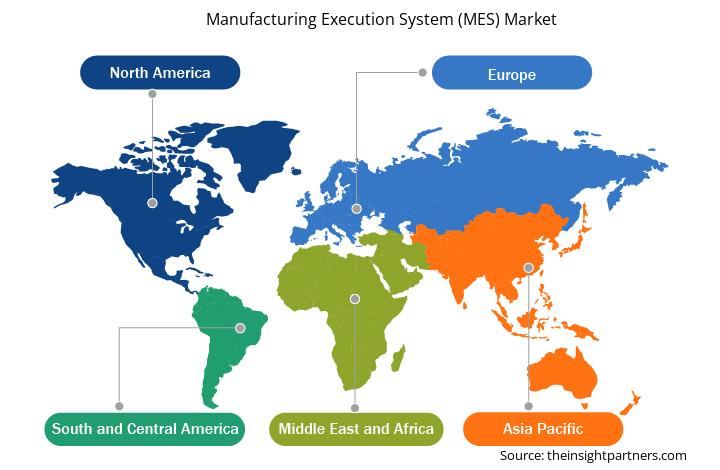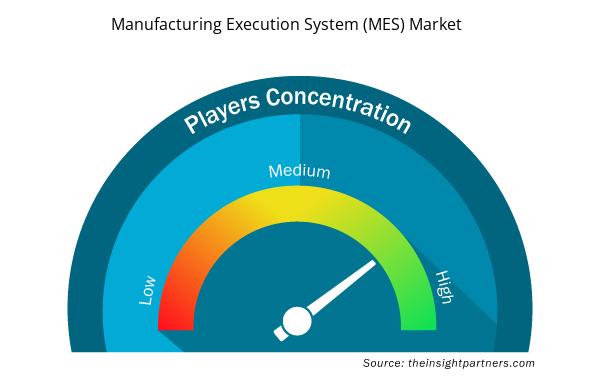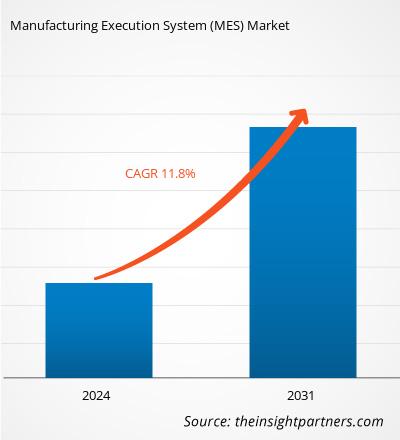Der Markt für Manufacturing Execution Systems (MES) hatte im Jahr 2024 ein Volumen von 16,66 Milliarden US-Dollar und soll bis 2031 36,13 Milliarden US-Dollar erreichen. Für den Zeitraum 2024–2031 wird eine durchschnittliche jährliche Wachstumsrate (CAGR) von 11,8 % erwartet. Die Integration von IIoT und Big Data Analytics dürfte weiterhin ein wichtiger Markttrend bleiben.
Marktanalyse für Manufacturing Execution System (MES)
Faktoren wie die digitale Transformation der Fertigungsindustrie, strenge Regulierungen in verschiedenen Branchen und der steigende Bedarf an Echtzeitdaten treiben das Wachstum des Marktes für Manufacturing Execution Systems (MES) voran . Der zunehmende Einsatz von MES in verschiedenen Branchen und der Aufstieg cloudbasierter MES-Lösungen in der Fertigung dürften Chancen für die Expansion des Marktes für Manufacturing Execution Systems (MES) schaffen. Darüber hinaus dürfte die Integration von IIoT und Big Data Analytics neue Trends für den Markt für Manufacturing Execution Systems (MES) setzen.
Marktübersicht für Manufacturing Execution System (MES)
Ein Manufacturing Execution System (MES) ist ein umfassendes, dynamisches Softwaresystem, das den gesamten Fertigungsprozess – vom Rohstoff bis zum fertigen Produkt – überwacht, verfolgt, dokumentiert und verwaltet. Es fungiert als funktionale Schicht zwischen Enterprise Resource Planning (ERP) und Prozessleitsystemen und liefert Entscheidungsträgern die Daten, die sie zur Verbesserung der Produktionseffizienz benötigen. Mit einem MES können Unternehmen den gesamten Fertigungsprozess – vom Rohstoffeingang bis zur Auslieferung des fertigen Produkts – verfolgen und steuern . Dies umfasst die Bearbeitung von Arbeitsaufträgen, die Überprüfung der Produktqualität, die Überwachung der Maschinenleistung und die Datenerfassung während des gesamten Produktionsprozesses.
Eine MES-Software dient der Verwaltung, Überwachung und Koordination der physischen Prozesse und des Personals in Echtzeit, die an der Umwandlung von Rohstoffen in Zwischenprodukte und/oder Fertigprodukte beteiligt sind. Darüber hinaus liefert sie verwertbare Daten, die Entscheidungsträgern in der Fertigung helfen, die Betriebsbedingungen in der Fabrik zu optimieren und so die Produktionsleistung zu steigern. MES-Software fungiert als Brücke zwischen PLM, ERP-Systemen (IT) und Maschinen (OT). Diese Softwareschicht verbessert die Effizienz und Qualität des Produktionsprozesses und führt so zu höherer Produktivität und Rentabilität.
Passen Sie diesen Bericht Ihren Anforderungen an
Sie erhalten kostenlos Anpassungen an jedem Bericht, einschließlich Teilen dieses Berichts oder einer Analyse auf Länderebene, eines Excel-Datenpakets sowie tolle Angebote und Rabatte für Start-ups und Universitäten
Markt für Manufacturing Execution System (MES):

- Informieren Sie sich über die wichtigsten Markttrends in diesem Bericht.Dieses KOSTENLOSE Beispiel umfasst eine Datenanalyse, die von Markttrends bis hin zu Schätzungen und Prognosen reicht.
Markttreiber und Chancen für Manufacturing Execution System (MES)
Strenge Vorschriften in verschiedenen Branchen
MES gewährleistet die Einhaltung der Branchenvorschriften durch lückenlose Rückverfolgbarkeit und Datenaufzeichnung. Es erfasst umfassende Informationen über die an der Herstellung beteiligten Rohstoffe, Komponenten, Prozesse und Bediener. Diese Daten ermöglichen es Herstellern, regulatorische Kriterien zu erfüllen und hohe Standards einzuhalten. Beispielsweise kann MES jeden Schritt des Herstellungsprozesses automatisch dokumentieren und so einen für behördliche Inspektionen erforderlichen Prüfpfad erstellen. Darüber hinaus analysiert es Qualitätskontrollparameter in Echtzeit, um sicherzustellen, dass die Produkte den Industriestandards entsprechen. Bei Abweichungen kann MES Warnmeldungen senden und Korrekturmaßnahmen ergreifen, um die Einhaltung der Vorschriften zu gewährleisten. MES bildet das Rückgrat des täglichen Betriebs in der Pharmaindustrie und ermöglicht eine präzise Echtzeitverwaltung aller Aspekte des Herstellungsprozesses. In der Pharmaindustrie ermöglicht MES die Erstellung elektronischer Chargenprotokolle (EBR) gemäß den strengen Kriterien der Guten Herstellungspraxis (GMP). Durch den Einsatz eines EBR-Systems stellt MES sicher, dass jeder Produktionsschritt genau dokumentiert wird, wodurch das Risiko menschlicher Fehler reduziert und die tägliche Betriebsverwaltung vereinfacht wird. Darüber hinaus erfüllen MES in der Lebensmittel- und Getränkeindustrie alle gesetzlichen und hygienischen Standards, einschließlich der Gefahrenanalyse und kritischer Kontrollpunkte (HACCP). Die Einführung von MES in der Lebensmittel- und Getränkeindustrie erfolgt am besten schrittweise, beginnend mit ausgewählten Produktionslinien oder -bereichen, um Störungen im Herstellungsprozess zu minimieren. Strenge regulatorische Standards in verschiedenen Branchen treiben daher das Marktwachstum für Manufacturing Execution Systems (MES) voran.
Zunehmende MES-Anwendungen in verschiedenen Branchen
MES-Lösungen lassen sich an die spezifischen Anforderungen verschiedener Branchen wie der Automobil-, Elektronik- und Pharmaindustrie anpassen. Die Grundfunktion eines MES bleibt dabei branchenübergreifend gleich. Eine Manufacturing Execution System (MES)-Lösung kann helfen, mit der zunehmend komplexen und sich schnell verändernden Automobilindustrie Schritt zu halten und die Fertigungsabläufe besser an die Marktanforderungen anzupassen. Ein MES nutzt hierfür drei Schlüsselfunktionen: Betriebsführung, Informationsmanagement und Integrationsgateway. Der Einsatz eines MES kann Automobilzulieferern helfen, den sich verändernden Branchentrends immer einen Schritt voraus zu sein. In der Automobilproduktion spielt ein MES eine entscheidende Rolle bei der Koordination komplexer Montagelinien. Ein MES verfolgt den Fortschritt der Fahrzeuge am Fließband, überwacht die Verfügbarkeit von Komponenten und synchronisiert Abläufe über verschiedene Arbeitsstationen hinweg. Batteriehersteller können ihr Qualitätsmanagement durch lückenlose Rückverfolgbarkeit von der Mischung bis zur Formulierung verbessern. Reifenhersteller können Effizienz- und Qualitätsstandards einhalten und gleichzeitig komplexe Reifenmischungen verarbeiten. Ein MES kann in vielen Bereichen messbare Verbesserungen liefern. Laut Rockwell Automation kann MES den Ausschuss um bis zu 8 %, die Durchlaufzeit um bis zu 45 %, die Zykluszeit um bis zu 45 %, die Arbeitskosten um bis zu 50 % und die Ausschussrate um bis zu 75 % reduzieren. Daher findet es Anwendung in verschiedenen Branchen. Daher wird erwartet, dass die zunehmende Anwendung von MES in verschiedenen Branchen lukrative Möglichkeiten für das Marktwachstum schafft.
Segmentierungsanalyse des Manufacturing Execution System (MES)-Marktberichts
Wichtige Segmente, die zur Ableitung der Marktanalyse für Manufacturing Execution System (MES) beigetragen haben, sind Komponente, Bereitstellung, Organisationsgröße, Lizenztyp, Vertriebskanal und Endbenutzer.
- Basierend auf den Komponenten ist der Markt in Software und Service segmentiert. Das Servicesegment ist weiter in Professional Services und Managed Services unterteilt. Das Softwaresegment dominierte den Markt im Jahr 2024.
- Hinsichtlich der Bereitstellung ist der Markt in On-Premise und Cloud segmentiert. Das Cloud-Segment ist weiter in Private Cloud, Public Cloud und Hybrid Cloud unterteilt. Die Cloud hatte im Jahr 2024 den größten Marktanteil.
- Der Markt für Manufacturing Execution System (MES) ist nach Unternehmensgröße in Großunternehmen und KMU unterteilt. Das Segment der Großunternehmen dominierte den Markt im Jahr 2024.
- Basierend auf dem Lizenztyp ist der Markt für Manufacturing Execution System (MES) in lizenzierte und abonnementbasierte Lizenzen segmentiert. Das abonnementbasierte Segment dominierte den Markt im Jahr 2024.
- Basierend auf den Vertriebskanälen wird der Markt in Direktvertrieb, Vertriebspartner und Drittanbieter unterteilt. Das Direktvertriebssegment dominierte den Markt im Jahr 2024.
- Basierend auf dem Endverbraucher ist der Markt in die Prozessindustrie und die diskrete Industrie segmentiert. Die Prozessindustrie ist weiter unterteilt in Lebensmittel und Getränke, Öl und Gas, Chemie, Zellstoff und Papier, Chemie, Energie und Strom, Pharmazeutika und Biowissenschaften, Wasser- und Abwasseraufbereitung und Sonstiges. Die diskrete Industrie ist weiter segmentiert in Automobil, Elektronik, Halbleiter, Luft- und Raumfahrt und Verteidigung, Konsumgüter, Medizinprodukte und Sonstiges. Die diskrete Industrie dominierte den Markt im Jahr 2024.
Manufacturing Execution System (MES) Marktanteilsanalyse nach Geografie
- Der Markt für Manufacturing Execution Systems (MES) ist in fünf Hauptregionen unterteilt: Nordamerika, Europa, Asien-Pazifik (APAC), Naher Osten und Afrika (MEA) sowie Süd- und Mittelamerika. Nordamerika dominierte den Markt für Manufacturing Execution Systems (MES) im Jahr 2024. Europa leistet den zweitgrößten Beitrag zum globalen Markt für Manufacturing Execution Systems (MES), gefolgt vom Asien-Pazifik-Raum.
- Der Markt für Manufacturing Execution Systems (MES) in Nordamerika ist in die USA, Kanada und Mexiko unterteilt. Nordamerika hält einen bedeutenden Marktanteil im Bereich Manufacturing Execution Systems (MES), der auf die fortschrittliche Fertigungsbasis der Region und die frühe Einführung von Industrie 4.0-Technologien zurückzuführen ist. Insbesondere die USA sind Sitz vieler MES-Softwareanbieter, darunter weltweit führende Unternehmen wie Rockwell Automation und Honeywell International Inc. MES werden in Nordamerika in Branchen wie der Automobilindustrie, der Luft- und Raumfahrt, der Pharmaindustrie und der Elektronik eingesetzt. Die zunehmende Bedeutung von Echtzeit-Datenanalyse, Produktionseffizienz und Einhaltung gesetzlicher Vorschriften treibt die Nachfrage nach MES-Lösungen an. Darüber hinaus verzeichnet der nordamerikanische Markt ein erhebliches Wachstum, da Hersteller und Behörden zunehmend die Vorteile der Echtzeit-Produktionsüberwachung und Prozessoptimierung erkennen. Staatliche Anreize für die digitale Transformation und die Einführung von Industrie 4.0 beschleunigen die Nachfrage nach MES-Systemen und kurbeln das Marktwachstum weiter an.
Regionale Einblicke in den Markt für Manufacturing Execution System (MES)
Die Analysten von Insight Partners haben die regionalen Trends und Faktoren, die den Markt für Manufacturing Execution Systeme (MES) im Prognosezeitraum beeinflussen, ausführlich erläutert. Dieser Abschnitt behandelt außerdem die Marktsegmente und die geografische Lage von Manufacturing Execution Systemen (MES) in Nordamerika, Europa, Asien-Pazifik, dem Nahen Osten und Afrika sowie Süd- und Mittelamerika.

- Erhalten Sie regionale Daten zum Manufacturing Execution System (MES)-Markt
Umfang des Marktberichts Manufacturing Execution System (MES)
| Berichtsattribut | Details |
|---|---|
| Marktgröße im Jahr 2024 | 16,66 Milliarden US-Dollar |
| Marktgröße bis 2031 | 36,13 Milliarden US-Dollar |
| Globale CAGR (2024 – 2031) | 11,8 % |
| Historische Daten | 2021-2023 |
| Prognosezeitraum | 2025–2031 |
| Abgedeckte Segmente | Nach Komponente
|
| Abgedeckte Regionen und Länder | Nordamerika
|
| Marktführer und wichtige Unternehmensprofile |
|
Marktteilnehmerdichte für Manufacturing Execution System (MES): Auswirkungen auf die Geschäftsdynamik
Der Markt für Manufacturing Execution Systeme (MES) wächst rasant. Die steigende Nachfrage der Endnutzer ist auf Faktoren wie veränderte Verbraucherpräferenzen, technologische Fortschritte und ein stärkeres Bewusstsein für die Produktvorteile zurückzuführen. Mit der steigenden Nachfrage erweitern Unternehmen ihr Angebot, entwickeln Innovationen, um den Bedürfnissen der Verbraucher gerecht zu werden, und nutzen neue Trends, was das Marktwachstum weiter ankurbelt.
Die Marktteilnehmerdichte beschreibt die Verteilung der in einem bestimmten Markt oder einer bestimmten Branche tätigen Unternehmen. Sie gibt an, wie viele Wettbewerber (Marktteilnehmer) in einem bestimmten Marktraum im Verhältnis zu dessen Größe oder Gesamtmarktwert präsent sind.
Die wichtigsten Unternehmen auf dem Markt für Manufacturing Execution Systeme (MES) sind:
- SAP SE
- ABB Ltd
- Dassault Systemes SE
- Schneider Electric SE
- Emerson Electric Co
- General Electric Co
Haftungsausschluss : Die oben aufgeführten Unternehmen sind nicht in einer bestimmten Reihenfolge aufgeführt.

- Überblick über die wichtigsten Akteure auf dem Manufacturing Execution System (MES)-Markt
Neuigkeiten und aktuelle Entwicklungen zum Manufacturing Execution System (MES)-Markt
Der Markt für Manufacturing Execution Systems (MES) wird durch die Erhebung qualitativer und quantitativer Daten aus Primär- und Sekundärforschung bewertet, die wichtige Unternehmenspublikationen, Verbandsdaten und Datenbanken umfasst. Nachfolgend sind einige Entwicklungen im Markt für Manufacturing Execution Systems (MES) aufgeführt:
- Emerson Automation Solutions gab bekannt, dass es seine Partnerschaft mit Informetric Systems Inc. erweitert hat. Emerson hat InfoBatch in das Syncade Manufacturing Execution System integriert. Emerson-Kunden können nun Daten aus Syncade, DeltaV und Datenbanken/Historikern von Drittanbietern mithilfe der InfoBatch-Berichtssuite aggregieren.
(Quelle: Emerson Automation Solutions, Pressemitteilung, November 2024)
- GE Digital, ein integraler Bestandteil des Energieportfolios von GE Vernova, kündigte auf dem 27. jährlichen ARC Industry Forum vom 6. bis 9. Februar in Orlando, Florida, neue Erweiterungen seiner cloudbasierten Manufacturing Execution Systems (MES)-Software im Proficy Smart Factory-Portfolio an. Die Proficy Smart Factory Cloud-MES-Software senkt die Investitions- (CAPEX) und Betriebskosten (OPEX) im Vergleich zu lokalen Implementierungen und unterstützt Prozess-, diskrete und gemischte Fertigungsumgebungen jeder Größe dabei, die Gesamtbetriebskosten (TCO) um bis zu 30 % zu senken, den Wartungsaufwand zu reduzieren und die Sicherheit zu verbessern.
(Quelle: GE Digital, Pressemitteilung, Februar 2023)
Marktbericht zum Manufacturing Execution System (MES): Umfang und Ergebnisse
Der Bericht „Manufacturing Execution System (MES)-Marktgröße und -prognose (2021–2031)“ bietet eine detaillierte Analyse des Marktes, die die unten genannten Bereiche abdeckt:
- Marktgröße und Prognose für Manufacturing Execution System (MES) auf globaler, regionaler und Länderebene für alle wichtigen Marktsegmente, die im Rahmen des Berichts abgedeckt sind
- Markttrends im Bereich Manufacturing Execution System (MES) sowie Marktdynamiken wie Treiber, Einschränkungen und wichtige Chancen
- Detaillierte PEST- und SWOT-Analyse
- Marktanalyse für Manufacturing Execution System (MES), die wichtige Markttrends, globale und regionale Rahmenbedingungen, wichtige Akteure, Vorschriften und aktuelle Marktentwicklungen umfasst
- Branchenlandschafts- und Wettbewerbsanalyse mit Marktkonzentration, Heatmap-Analyse, prominenten Akteuren und jüngsten Entwicklungen für den Markt für Manufacturing Execution System (MES)
- Detaillierte Firmenprofile
- Historische Analyse (2 Jahre), Basisjahr, Prognose (7 Jahre) mit CAGR
- PEST- und SWOT-Analyse
- Marktgröße Wert/Volumen – Global, Regional, Land
- Branche und Wettbewerbsumfeld
- Excel-Datensatz


- Blood Collection Devices Market
- Single-Use Negative Pressure Wound Therapy Devices Market
- Electronic Signature Software Market
- Photo Printing Market
- Dropshipping Market
- Medical Audiometer Devices Market
- Transdermal Drug Delivery System Market
- Collagen Peptides Market
- Medical Enzyme Technology Market
- Battery Testing Equipment Market

Report Coverage
Revenue forecast, Company Analysis, Industry landscape, Growth factors, and Trends

Segment Covered
This text is related
to segments covered.

Regional Scope
North America, Europe, Asia Pacific, Middle East & Africa, South & Central America

Country Scope
This text is related
to country scope.
Häufig gestellte Fragen
The manufacturing execution system (MES) market was valued at US$ 16.66 billion in 2024 and is projected to reach US$ 36.13 billion by 2031; it is expected to grow at a CAGR of 11.8% during 2025–2031.
Leveraging Integration of IIoT and Big Data Analytics is the future trends of the manufacturing execution system (MES) market.
The North America held the largest market share in 2024, followed by Europe.
The key players, holding majority shares, in manufacturing execution system (MES) market includes IBM Corporation, Microsoft Corporation, Oracle Corporation, and SAP SE.
The manufacturing execution system (MES) market are expected to reach US$ 36.13 billion in the year 2031.
Manufacturing industries embrace digital transformation and stringent regulations across diverse industries are the driving factors impacting the manufacturing execution system (MES) market.
Trends and growth analysis reports related to Technology, Media and Telecommunications : READ MORE..
The List of Companies - Manufacturing Execution System (MES) Market
- SAP SE
- ABB Ltd
- Dassault Systemes SE
- Schneider Electric SE
- Emerson Electric Co
- General Electric Co
- Honeywell International Inc
- Rockwell Automation Inc
- Siemens AG
- PSI Software SE
- EAZYWORKS INC.
- Eyelit Technologies
- Glorysoft (Shanghai) Co.,Ltd
- Oracle Corp
- Applied Materials Inc
- Autodesk Inc
- International Business Machines Corp
- IFS AB
- FA software (Shanghai) Co., Ltd
- 42Q
- INFOR
- SEDAPTA SRL
- KORBER AG
- ECI SOFTWARE SOLUTIONS
The Insight Partners performs research in 4 major stages: Data Collection & Secondary Research, Primary Research, Data Analysis and Data Triangulation & Final Review.
- Data Collection and Secondary Research:
As a market research and consulting firm operating from a decade, we have published and advised several client across the globe. First step for any study will start with an assessment of currently available data and insights from existing reports. Further, historical and current market information is collected from Investor Presentations, Annual Reports, SEC Filings, etc., and other information related to company’s performance and market positioning are gathered from Paid Databases (Factiva, Hoovers, and Reuters) and various other publications available in public domain.
Several associations trade associates, technical forums, institutes, societies and organization are accessed to gain technical as well as market related insights through their publications such as research papers, blogs and press releases related to the studies are referred to get cues about the market. Further, white papers, journals, magazines, and other news articles published in last 3 years are scrutinized and analyzed to understand the current market trends.
- Primary Research:
The primarily interview analysis comprise of data obtained from industry participants interview and answers to survey questions gathered by in-house primary team.
For primary research, interviews are conducted with industry experts/CEOs/Marketing Managers/VPs/Subject Matter Experts from both demand and supply side to get a 360-degree view of the market. The primary team conducts several interviews based on the complexity of the markets to understand the various market trends and dynamics which makes research more credible and precise.
A typical research interview fulfils the following functions:
- Provides first-hand information on the market size, market trends, growth trends, competitive landscape, and outlook
- Validates and strengthens in-house secondary research findings
- Develops the analysis team’s expertise and market understanding
Primary research involves email interactions and telephone interviews for each market, category, segment, and sub-segment across geographies. The participants who typically take part in such a process include, but are not limited to:
- Industry participants: VPs, business development managers, market intelligence managers and national sales managers
- Outside experts: Valuation experts, research analysts and key opinion leaders specializing in the electronics and semiconductor industry.
Below is the breakup of our primary respondents by company, designation, and region:

Once we receive the confirmation from primary research sources or primary respondents, we finalize the base year market estimation and forecast the data as per the macroeconomic and microeconomic factors assessed during data collection.
- Data Analysis:
Once data is validated through both secondary as well as primary respondents, we finalize the market estimations by hypothesis formulation and factor analysis at regional and country level.
- Macro-Economic Factor Analysis:
We analyse macroeconomic indicators such the gross domestic product (GDP), increase in the demand for goods and services across industries, technological advancement, regional economic growth, governmental policies, the influence of COVID-19, PEST analysis, and other aspects. This analysis aids in setting benchmarks for various nations/regions and approximating market splits. Additionally, the general trend of the aforementioned components aid in determining the market's development possibilities.
- Country Level Data:
Various factors that are especially aligned to the country are taken into account to determine the market size for a certain area and country, including the presence of vendors, such as headquarters and offices, the country's GDP, demand patterns, and industry growth. To comprehend the market dynamics for the nation, a number of growth variables, inhibitors, application areas, and current market trends are researched. The aforementioned elements aid in determining the country's overall market's growth potential.
- Company Profile:
The “Table of Contents” is formulated by listing and analyzing more than 25 - 30 companies operating in the market ecosystem across geographies. However, we profile only 10 companies as a standard practice in our syndicate reports. These 10 companies comprise leading, emerging, and regional players. Nonetheless, our analysis is not restricted to the 10 listed companies, we also analyze other companies present in the market to develop a holistic view and understand the prevailing trends. The “Company Profiles” section in the report covers key facts, business description, products & services, financial information, SWOT analysis, and key developments. The financial information presented is extracted from the annual reports and official documents of the publicly listed companies. Upon collecting the information for the sections of respective companies, we verify them via various primary sources and then compile the data in respective company profiles. The company level information helps us in deriving the base number as well as in forecasting the market size.
- Developing Base Number:
Aggregation of sales statistics (2020-2022) and macro-economic factor, and other secondary and primary research insights are utilized to arrive at base number and related market shares for 2022. The data gaps are identified in this step and relevant market data is analyzed, collected from paid primary interviews or databases. On finalizing the base year market size, forecasts are developed on the basis of macro-economic, industry and market growth factors and company level analysis.
- Data Triangulation and Final Review:
The market findings and base year market size calculations are validated from supply as well as demand side. Demand side validations are based on macro-economic factor analysis and benchmarks for respective regions and countries. In case of supply side validations, revenues of major companies are estimated (in case not available) based on industry benchmark, approximate number of employees, product portfolio, and primary interviews revenues are gathered. Further revenue from target product/service segment is assessed to avoid overshooting of market statistics. In case of heavy deviations between supply and demand side values, all thes steps are repeated to achieve synchronization.
We follow an iterative model, wherein we share our research findings with Subject Matter Experts (SME’s) and Key Opinion Leaders (KOLs) until consensus view of the market is not formulated – this model negates any drastic deviation in the opinions of experts. Only validated and universally acceptable research findings are quoted in our reports.
We have important check points that we use to validate our research findings – which we call – data triangulation, where we validate the information, we generate from secondary sources with primary interviews and then we re-validate with our internal data bases and Subject matter experts. This comprehensive model enables us to deliver high quality, reliable data in shortest possible time.

 Holen Sie sich ein kostenloses Muster für diesen Bericht
Holen Sie sich ein kostenloses Muster für diesen Bericht